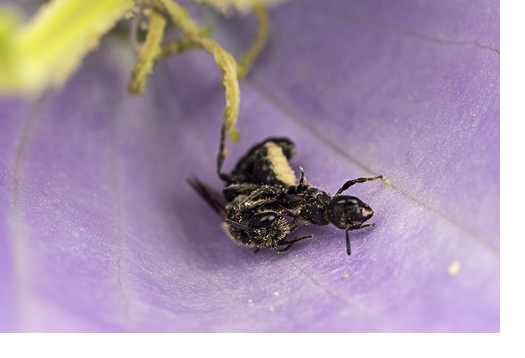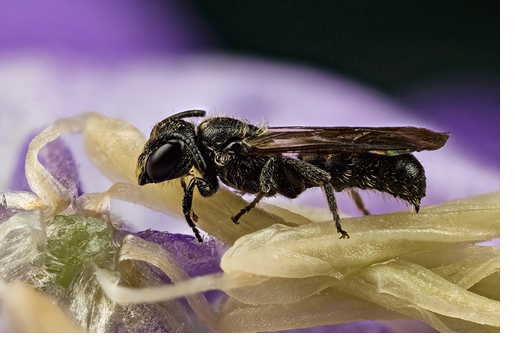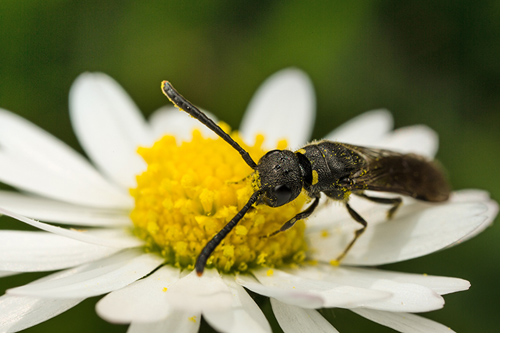Chelostoma Bees and Cleptoparasites
08th July 2013
In: July 2013
The UK is host to two species of Chelostoma bees, the Harebell Carpenter Bee (Chelostoma campanularum) and the Sleepy Carpenter Bee (Chelostoma florisomne). The species name "florisomne" translates roughly to "flower sleeper". Both bees are black with narrow elongated bodies, but florisomne is larger than campanularum and has white hairs bands on the abdomen.
 I haven't yet encountered Chelostoma florisomne, but have been fortunate enough to have Chelostoma campanularum active in the garden both this year and last. At just 6-7mm long and 1mm wide, this is one of the UK's smallest bees. We have just one campanula flower in the garden this year, but within 24 hours of the first flowers opening, around ten Harebell Carpenter Bees were flying around them; both males and females. Males patrol the flowers waiting for females to arrive. Mating often takes place inside the blooms (Image left).
I haven't yet encountered Chelostoma florisomne, but have been fortunate enough to have Chelostoma campanularum active in the garden both this year and last. At just 6-7mm long and 1mm wide, this is one of the UK's smallest bees. We have just one campanula flower in the garden this year, but within 24 hours of the first flowers opening, around ten Harebell Carpenter Bees were flying around them; both males and females. Males patrol the flowers waiting for females to arrive. Mating often takes place inside the blooms (Image left).
 As the name suggests, Chelostoma florisomne is noted for its habit of sleeping in flowers. Its favourite flower both for feeding and sleeping is the buttercup (Ranunculus). But Chelostoma campanularum can also be found sleeping in their favourite flowers. I found this male deep inside a campanula flower in the garden this morning. It was looking a bit bedragled, probably because the garden had been watered last night. I carefully removed the flower and cut away the upper part of the petals to give better access to the bee for photography.
As the name suggests, Chelostoma florisomne is noted for its habit of sleeping in flowers. Its favourite flower both for feeding and sleeping is the buttercup (Ranunculus). But Chelostoma campanularum can also be found sleeping in their favourite flowers. I found this male deep inside a campanula flower in the garden this morning. It was looking a bit bedragled, probably because the garden had been watered last night. I carefully removed the flower and cut away the upper part of the petals to give better access to the bee for photography.
I took quite a few shots without the bee making any movements at all. Because of this inactivity, I decided to attempt a focus-stack. This involves setting the lens to a wide aperture (I chose F6.3). This improves image quality, but reduces the depth-of field. The technique is to steady the camera (I rest it on a beanbag), focus on the nearest part of the insect and take a shot. The camera is then gradually moved forwards (a fraction at a time), taking another shot at each position. The separate images are then all aligned and "stacked" using special software. I used Zerene Stacker. As long as the subject hasn't moved too much, it's a useful technique.
This particular image is a combination of twenty two separate photographs. The stacked image has much more depth-of-field but without the image degredation found with narrower apertures.
 The Harebell Carpenter Bee is fortunate in that it has no known cleptoparasites. Many bees have associated bees or wasps (cuckoo bees/wasps) that "steal" a host bee's food stores, by entering the host's nest and laying their own eggs there. Chelostoma florisomne does have a specific cleptoparasite; the nationally-scarce Sapygid wasp Monosapyga clavicornis (image left).
The Harebell Carpenter Bee is fortunate in that it has no known cleptoparasites. Many bees have associated bees or wasps (cuckoo bees/wasps) that "steal" a host bee's food stores, by entering the host's nest and laying their own eggs there. Chelostoma florisomne does have a specific cleptoparasite; the nationally-scarce Sapygid wasp Monosapyga clavicornis (image left).
I saw this for the first (and only) time last week, in our local churchyard. I had walked around several times looking for interesting insects and had seen nothing at all. I decided on another "circuit" and saw just this one (a female I think) feeding on a daisy flower. Luckily I managed a couple of photographs before it flew off. I had no idea at the time, what it was. There have only been a few records in Warwickshire, so it was a lucky find. Just need to find Chelostoma florisomne now!
 I haven't yet encountered Chelostoma florisomne, but have been fortunate enough to have Chelostoma campanularum active in the garden both this year and last. At just 6-7mm long and 1mm wide, this is one of the UK's smallest bees. We have just one campanula flower in the garden this year, but within 24 hours of the first flowers opening, around ten Harebell Carpenter Bees were flying around them; both males and females. Males patrol the flowers waiting for females to arrive. Mating often takes place inside the blooms (Image left).
I haven't yet encountered Chelostoma florisomne, but have been fortunate enough to have Chelostoma campanularum active in the garden both this year and last. At just 6-7mm long and 1mm wide, this is one of the UK's smallest bees. We have just one campanula flower in the garden this year, but within 24 hours of the first flowers opening, around ten Harebell Carpenter Bees were flying around them; both males and females. Males patrol the flowers waiting for females to arrive. Mating often takes place inside the blooms (Image left). As the name suggests, Chelostoma florisomne is noted for its habit of sleeping in flowers. Its favourite flower both for feeding and sleeping is the buttercup (Ranunculus). But Chelostoma campanularum can also be found sleeping in their favourite flowers. I found this male deep inside a campanula flower in the garden this morning. It was looking a bit bedragled, probably because the garden had been watered last night. I carefully removed the flower and cut away the upper part of the petals to give better access to the bee for photography.
As the name suggests, Chelostoma florisomne is noted for its habit of sleeping in flowers. Its favourite flower both for feeding and sleeping is the buttercup (Ranunculus). But Chelostoma campanularum can also be found sleeping in their favourite flowers. I found this male deep inside a campanula flower in the garden this morning. It was looking a bit bedragled, probably because the garden had been watered last night. I carefully removed the flower and cut away the upper part of the petals to give better access to the bee for photography.I took quite a few shots without the bee making any movements at all. Because of this inactivity, I decided to attempt a focus-stack. This involves setting the lens to a wide aperture (I chose F6.3). This improves image quality, but reduces the depth-of field. The technique is to steady the camera (I rest it on a beanbag), focus on the nearest part of the insect and take a shot. The camera is then gradually moved forwards (a fraction at a time), taking another shot at each position. The separate images are then all aligned and "stacked" using special software. I used Zerene Stacker. As long as the subject hasn't moved too much, it's a useful technique.
This particular image is a combination of twenty two separate photographs. The stacked image has much more depth-of-field but without the image degredation found with narrower apertures.
 The Harebell Carpenter Bee is fortunate in that it has no known cleptoparasites. Many bees have associated bees or wasps (cuckoo bees/wasps) that "steal" a host bee's food stores, by entering the host's nest and laying their own eggs there. Chelostoma florisomne does have a specific cleptoparasite; the nationally-scarce Sapygid wasp Monosapyga clavicornis (image left).
The Harebell Carpenter Bee is fortunate in that it has no known cleptoparasites. Many bees have associated bees or wasps (cuckoo bees/wasps) that "steal" a host bee's food stores, by entering the host's nest and laying their own eggs there. Chelostoma florisomne does have a specific cleptoparasite; the nationally-scarce Sapygid wasp Monosapyga clavicornis (image left). I saw this for the first (and only) time last week, in our local churchyard. I had walked around several times looking for interesting insects and had seen nothing at all. I decided on another "circuit" and saw just this one (a female I think) feeding on a daisy flower. Luckily I managed a couple of photographs before it flew off. I had no idea at the time, what it was. There have only been a few records in Warwickshire, so it was a lucky find. Just need to find Chelostoma florisomne now!
Comments
 By Amelia: I have just started noticing tiny bees this year so this was much appreciated. I did know that there was a bee particularly attracted to Campanula and I have been watching mine but have seen nothing in it, so far.
By Amelia: I have just started noticing tiny bees this year so this was much appreciated. I did know that there was a bee particularly attracted to Campanula and I have been watching mine but have seen nothing in it, so far. By Vivian Russell: This was fascinating, thank you.
By Vivian Russell: This was fascinating, thank you.